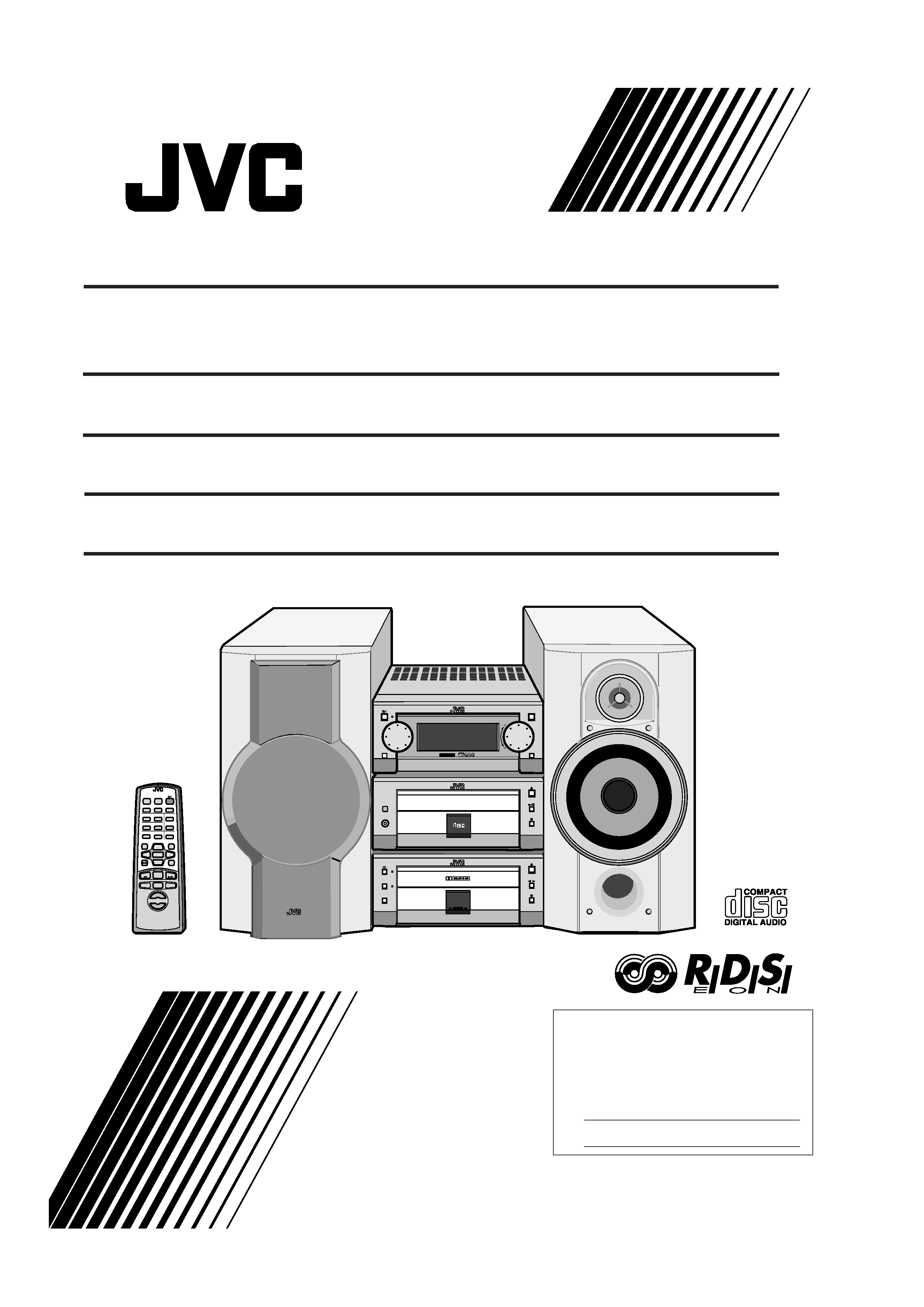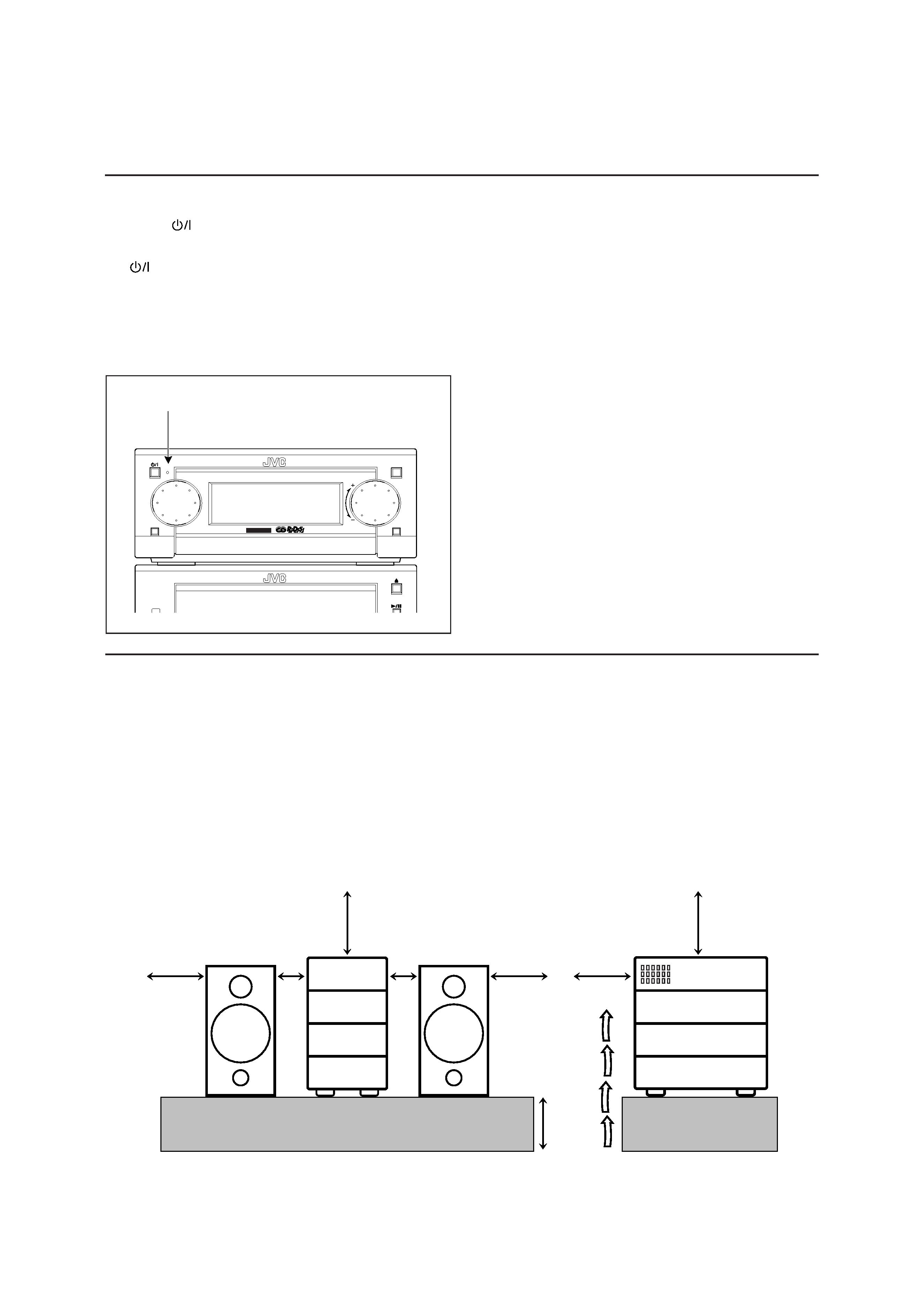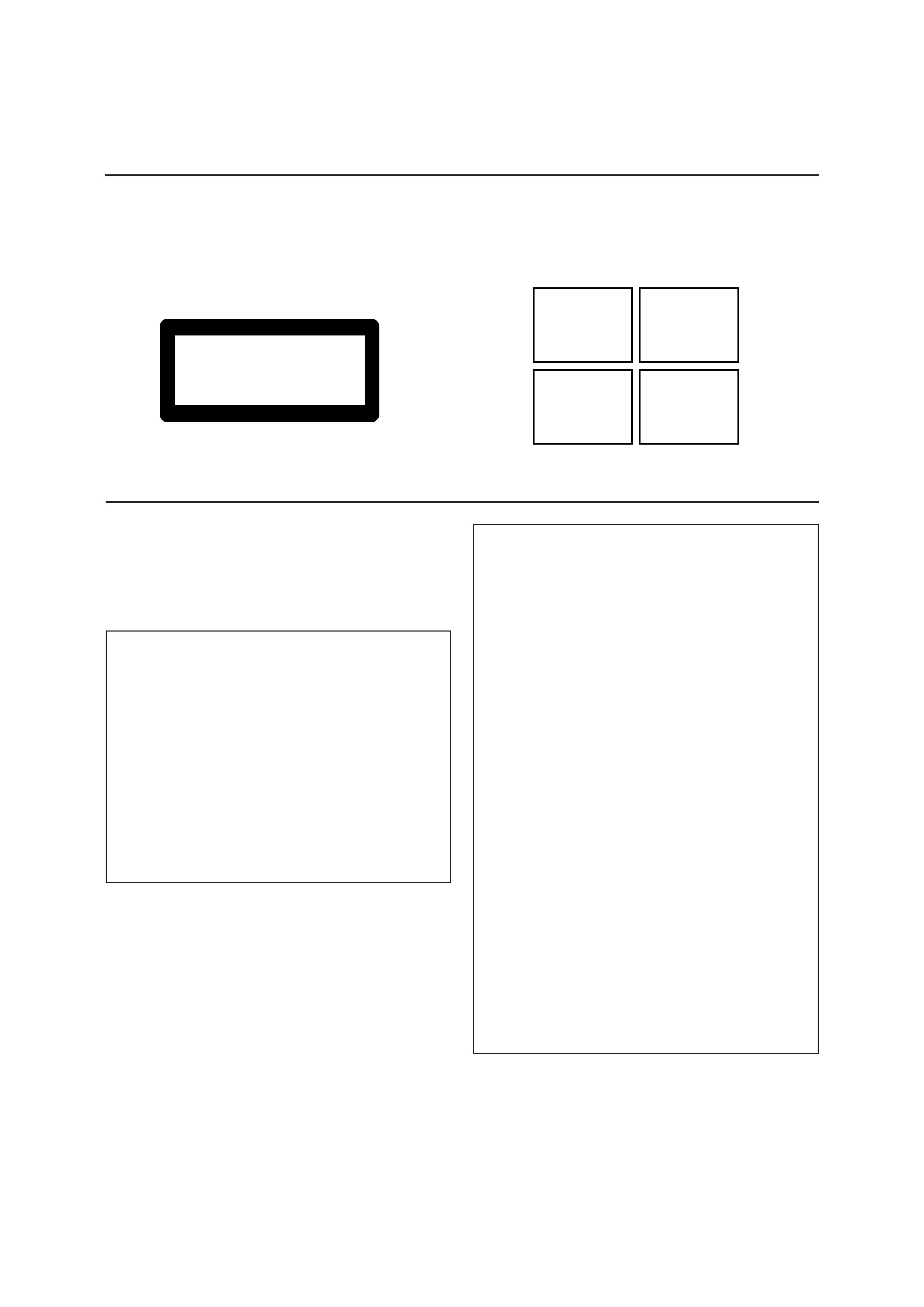
COMPACT DISC/TUNER
CASSETTE DECK
For Customer Use:
Enter below the Model No. and Serial
No. which are located either on the rear,
bottom or side of the cabinet. Retain this
information for future reference.
Model No.
Serial No.
LVT0705-003A
[B]
UX-G66R
Consists of AX-UXG66, XT-UXG66R,
TD-UXG66, and SP-UXG66.
MICRO COMPONENT SYSTEM
INSTRUCTIONS
STEREO AMPLIFIER
AX-UXG66
XT-UXG66R
TD-UXG66
SP-UXG66
SPEAKER SYSTEM
MICRO
COMPONENT
SYSTEM
UX-G66R
MOS - FET
OPEN/CLOSE
AUX
VOLUME
MULTI
FM/AM
STANDBY/ON
JOG
1BIT
P·E·M
D·D· CONVER TER
PHONES
COMPACT
DIGITAL AUDIO
REC PAUSE
DOLBY B NR
AUTO
REVERSE
REC
>
<
MD
DOWN
SET
UP
ENTER
AUTO PRESET
PLAY MODE
FM MODE
CANCEL
BASS
SLEEP
PANEL
OPEN/CLOSE
REMOTE CONTROL RM-SUXG6R
AUX
TITTLE/EDIT
REPEAT
TREBLE
DIMMER
CLOCK/TIMER
DISPLAY
/CHARA.
ACTIVE
BASS EX.
PTY/EON
VOLUME
FM/AM
4
7
¢
+
CD
TAPE
cover[B]f
12/14/00, 9:54 AM
1

Warnings, Cautions and Others
Caution
switch!
Disconnect the mains plug to shut the power off completely (the
STANDBY/ON lamp goes off).
The
switch in any position does not disconnect the mains line.
· When the unit is on standby, the STANDBY/ON lamp lights red.
· When the unit is turned on, the STANDBY/ON lamp lights
green.
The power can be remote controlled.
CAUTION
To reduce the risk of electrical shocks, fire, etc.:
1.
Do not remove screws, covers or cabinet.
2.
Do not expose this appliance to rain or moisture.
Caution: Proper Ventilation
To avoid risk of electric shock and fire, and to prevent damage,
locate the apparatus as follows:
1 Front:
No obstructions and open spacing.
2 Sides/ Top/ Back:
No obstructions should be placed in the areas shown by the
dimensions below.
3 Bottom:
Place on the level surface. Maintain an adequate air path for
ventilation by placing on a stand with a height of 10 cm or
more.
G-1
Front view
Side view
The STANDBY/ON lamp
1 cm
15 cm
15 cm
15 cm
10 cm
1 cm
15 cm
15 cm
AX-UXG66
TD-UXG66
XT-UXG66R
XM-G6
AX-UXG66
TD-UXG66
XT-UXG66R
XM-G6
1BIT
P·E·M
D·D· CONVER TER
MICR O
COMPONENT
SYSTEM
UX-G66R
MOS - FET
OPEN/CLOSE
AUX
VOLUME
MULTI
FM/AM
STANDBY/ON
JOG
safety[B]f
01.1.19, 2:22 PM
1

IMPORTANT FOR LASER PRODUCTS
2 WARNING LABEL, PLACED INSIDE THE UNIT
REPRODUCTION OF LABELS
1 CLASSIFICATION LABEL, PLACED ON EXTERIOR
SURFACE
CLASS
1
LASER
PRODUCT
1.
CLASS 1 LASER PRODUCT
2.
DANGER: Invisible laser radiation when open and interlock
failed or defeated. Avoid direct exposure to beam.
3.
CAUTION: Do not open the top cover. There are no user
serviceable parts inside the Unit; leave all servicing to
qualified service personnel.
DANGER: Invisible laser
radiation when open and
interlock failed or defeated.
AVOID DIRECT EXPOSURE
TO BEAM.
(e)
ADVARSEL: Usynlig laser-
stråling ved åbning, når
sikkerhedsafbrydere er ude
af funktion. Undgå udsæt-
telse for stråling
(d)
VARNING: Osynlig laser-
strålning när denna del är
öppnad och spärren är
urkopplad.
Betrakta
ej
strålen.
(s)
VARO: Avattaessa ja suo-
jalukitus ohitettaessa olet
alttiina
näkymättömälle
lasersäteilylle. Älä katso
säteeseen.
(f)
G-2
CAUTION
·
Do not block the ventilation openings or holes.
(If the ventilation openings or holes are blocked by a
newspaper or cloth, etc., the heat may not be able to
get out.)
·
Do not place any naked flame sources, such as lighted
candles, on the apparatus.
·
When discarding batteries, environmental problems
must be considered and local rules or laws governing
the disposal of these batteries must be followed
strictly.
·
Do not use this apparatus in a bathroom or places with
water. Also do not place any containers filled with
water or liquids (such as cosmetics or medicines,
flower vases, potted plants, cups, etc.) on top of this
apparatus.
IMPORTANT for the U.K.
DO NOT cut off the mains plug from this equipment. If the
plug fitted is not suitable for the power points in your
home or the cable is too short to reach a power point,
then obtain an appropriate safety approved extension
lead or consult your dealer.
BE SURE to replace the fuse only with an identical
approved type, as originally fitted.
If nontheless the mains plug is cut off ensure to remove
the fuse and dispose of the plug immediately, to avoid a
possible shock hazard by inadvertent connection to the
mains supply.
If this product is not supplied fitted with a mains plug then
follow the instructions given below:
IMPORTANT:
DO NOT make any connection to the terminal which is
marked with the letter E or by the safety earth symbol or
coloured green or green-and-yellow.
The wires in the mains lead on this product are coloured
in accordance with the following code:
Blue :
Neutral
Brown :
Live
As these colours may not correspond with the coloured
markings identifying the terminals in your plug proceed as
follows:
The wire which is coloured blue must be connected to the
terminal which is marked with the letter N or coloured
black.
The wire which is coloured brown must be connected to
the terminal which is marked with the letter L or coloured
red.
IF IN DOUBT - CONSULT A COMPETENT ELECTRICIAN.
safety[B]f
01.1.19, 2:22 PM
2

1
Power sources
· When unplugging from the wall outlet, always pull the
plug, not the AC power cord.
DO NOT handle the AC power cord with wet
hands.
Moisture condensation
Moisture may condense on the lens inside the units in the
following cases:
· After starting heating in the room
· In a damp room
· If the units are brought directly from a cold to a warm
place
Should this occur, the system may malfunction. In this case,
leave the units turned on for a few hours until the moisture
evaporates, unplug the AC power cord, and then plug it in
again.
Others
· Should any metallic object or liquid fall into a unit, unplug
the units and consult your dealer before operating any
further.
· If you are not going to operate the units for an extended
period of time, unplug the AC power cord from the wall
outlet.
DO NOT disassemble the units since there are
no user serviceable parts inside.
If anything goes wrong, unplug the AC power cord and
consult your dealer.
About This Manual
This manual is organized as follows:
· The manual mainly explains operations using the buttons
and controls on the units. You can also use the buttons on
the remote control if they have the same or similar names
(or marks) as those on the units.
If operation using the remote control is different from
that using each unit, it is then explained.
· Basic and common information that is the same for many
functions is grouped in one place, and is not repeated in
each procedure. For instance, we do not repeat the
information about turning on/off the system, setting the
volume, changing the sound effects, and others, which
are explained in the section "Basic Settings" and
"Common Operations" on pages 10 to 13.
· The following marks are used in this manual:
Gives you warnings and cautions to
prevent from a damage or risk of fire/
electric shock.
Also gives you information which is not
good for obtaining the best possible
performance from the units.
Gives you information and hints you had
better know.
Precautions
Installation
· Install in a place which is level, dry and neither too hot
nor too cold -- between 5°C (41°F) and 35°C (95°F).
· Install the units in a location with adequate ventilation to
prevent internal heat buildup in the units.
· Leave sufficient distance between the units and the TV.
· Keep the speakers away from the TV to avoid interference
with TV.
DO NOT install the units in a location near heat
sources, or in a place subject to direct sunlight,
excessive dust or vibration.
We would like to thank you for purchasing one of our JVC products.
Before operating this micro component system, read this manual carefully
and thoroughly to obtain the best possible performance from your system,
and retain this manual for future reference.
Introduction
EN01-13.UX-G66R[B]f
12/8/00, 8:02 PM
1

2
Contents
Introduction .......................................................... 1
About This Manual ............................................................... 1
Precautions ........................................................................... 1
Contents ................................................................. 2
Location of the Buttons and Controls ................. 3
Front Panels .......................................................................... 4
Remote Control .................................................................... 5
Getting Started ...................................................... 6
Unpacking ............................................................................ 6
Putting the Batteries into the Remote Control ...................... 6
Connecting the System Control Cables and the External
Wire .................................................................................. 6
Connecting MD Recorder XM-G6 ....................................... 7
Connecting Sub Woofer System ........................................... 7
Connecting Antennas ............................................................ 7
Connecting Speakers ............................................................ 8
Connecting Other Equipments ............................................. 9
Basic Settings ...................................................... 10
Setting the Clock ................................................................ 10
Setting the Display Illumination (Dimmer) ........................ 10
Common Operations .......................................... 11
Turning On the Power and Selecting the Sources .............. 11
Adjusting the Volume ......................................................... 11
Reinforcing the Bass Sound ............................................... 12
Adjusting Bass and Treble Sounds ..................................... 12
Operating the Sliding Panel ................................................ 13
Listening to the External Equipment .................................. 13
Listening to FM and AM Broadcasts ................ 14
Tuning in a Station ............................................................. 14
Presetting Stations .............................................................. 15
Receiving FM Stations with RDS ...................... 16
Changing the RDS Information .......................................... 16
Searching for Programs by PTY Codes (PTY Search) ...... 17
Switching to a Program Type Temporarily ......................... 17
Playing Back a CD .............................................. 20
Playing Back the Entire Disc -- Normal Play ................... 20
Searching and Skipping Tracks .......................................... 21
Programing the Playing Order of the Tracks
-- Program Play ............................................................. 21
Playing at Random -- Random Play .................................. 23
Repeating Tracks -- Repeat Play ....................................... 23
Playing Back a Tape ........................................... 24
Playing Back a Tape -- Basic Operation ........................... 24
Fast-Winding a Tape ........................................................... 25
Searching and Skipping to Each Program
-- Music Scan ................................................................ 25
Playing Back Dolby-Recorded Tape .................................. 25
Recording onto a Tape ........................................ 26
Manual Recording onto a Tape ........................................... 26
Recording in Auto Reverse ................................................. 27
Synchronized Recording from a CD .................................. 28
Recording from the external equipment ............................. 28
Using the Timers ................................................. 29
Using Recording Timer ...................................................... 29
Using Daily Timer .............................................................. 30
Using Sleep Timer .............................................................. 32
Timer Priority ..................................................................... 32
Maintenance and Additional Information ........ 33
Handling CDs ..................................................................... 33
Handling Cassette Tapes ..................................................... 34
Types of Cassette Tapes ...................................................... 34
Troubleshooting .................................................. 35
Specifications ....................................................... 36
EN01-13.UX-G66R[B]f
12/8/00, 8:02 PM
2
